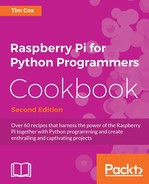 2. Starting with Python Strings, Files, and Menus
by Tim Cox
Raspberry Pi for Python Programmers Cookbook - Second Edition
2. Starting with Python Strings, Files, and Menus
by Tim Cox
Raspberry Pi for Python Programmers Cookbook - Second Edition
- Raspberry Pi for Python Programmers Cookbook - Second Edition
- Table of Contents
- Raspberry Pi for Python Programmers Cookbook - Second Edition
- Credits
- About the Author
- About the Reviewer
- www.PacktPub.com
- Preface
- 1. Getting Started with a Raspberry Pi Computer
- Introduction
- Connecting the Raspberry Pi
- Using NOOBS to set up your Raspberry Pi SD card
- Networking and connecting your Raspberry Pi to the Internet via the LAN connector
- Using built-in Wi-Fi and Bluetooth on the Raspberry Pi
- Configuring your network manually
- Networking directly to a laptop or computer
- Networking and connecting your Raspberry Pi to the Internet via a USB Wi-Fi dongle
- Connecting to the Internet through a proxy server
- Connecting remotely to the Raspberry Pi over the network using VNC
- Connecting remotely to the Raspberry Pi over the network using SSH (and X11 Forwarding)
- Sharing the home folder of the Raspberry Pi with SMB
- Keeping the Raspberry Pi up to date
- 2. Starting with Python Strings, Files, and Menus
- 3. Using Python for Automation and Productivity
- 4. Creating Games and Graphics
- 5. Creating 3D Graphics
- 6. Using Python to Drive Hardware
- 7. Sense and Display Real-World Data
- 8. Creating Projects with the Raspberry Pi Camera Module
- 9. Building Robots
- 10. Interfacing with Technology
In this chapter, we will cover the following topics:
- Working with text and strings
- Using files and handling errors
- Creating a boot-up menu
- Creating a self-defining menu
In this chapter, we discuss how to use Python to perform some basic encryption by scrambling letters. This will introduce some basic string manipulation, user input, progressing on to creating reusable modules, and graphical user interfaces.
To follow, we will create some useful Python scripts that can be added to run as the Raspberry Pi boots or an easy-to-run command that will provide quick shortcuts to common or frequently-used commands. Taking this further, we will make use of threading to run multiple tasks and introduce classes to define multiple objects.
As it is customary to start any programming exercise with a Hello World example, we will kick off with that now.
Create the hellopi.py file using nano, as follows:
nano -c hellopi.py
Within our hellopi.py file, add the following code:
#!/usr/bin/python3
#hellopi.py
print ("Hello Raspberry Pi")When done, save and exit (Ctrl + X, Y, and Enter). To run the file, use the following command:
python3 hellopi.py
Congratulations, you have created your first program!
Your result should be similar to the following screenshot:

The Hello Raspberry Pi output
-
No Comment